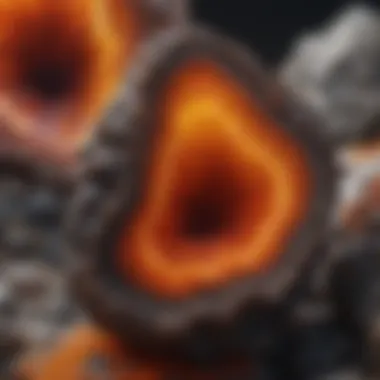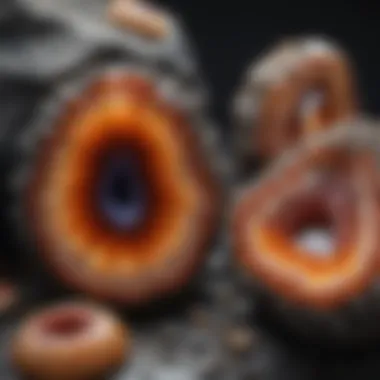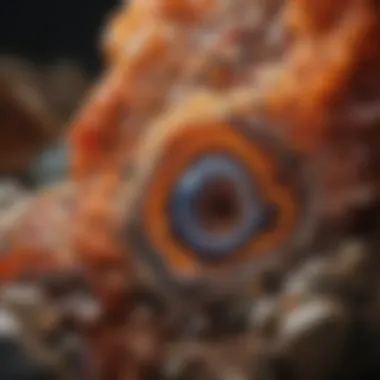Unlocking the Enigma of Agate: A Definitive Guide for Enthusiasts


Rock and Fossil Identification
As rock and fossil enthusiasts embark on the journey of identifying agate, it is essential to delve into the intricate world of rock and fossil identification. Understanding the different types of rocks and fossils is paramount in distinguishing agate from other geological specimens. Characteristics such as color variations, banding patterns, and translucency are key indicators to look for when examining agate specimens. Utilizing the appropriate tools for identification, such as magnifying lenses and hardness testing tools, can aid in accurately distinguishing agate from similar-looking gemstones.
Collecting Tips and Techniques
In the realm of collecting agate, rock and fossil enthusiasts are encouraged to adhere to best practices to ensure a successful and ethical collecting experience. Locating prime collecting sites, such as river banks or quarries known for agate deposits, can increase the chances of discovering high-quality specimens. When extracting agate specimens from their geological settings, it is crucial to employ safe techniques to avoid damage to the specimens and surrounding environment. Tools like chisels and brushes can aid in safely extracting agate specimens without compromising their integrity.
Preservation and Display
Once agate specimens are collected, enthusiasts must explore various techniques for preserving their geological treasures. Proper storage methods, such as keeping specimens in padded containers to prevent scratching and shattering, can prolong the lifespan of agate specimens. Additionally, creative display ideas, like using shadow boxes or glass cabinets to showcase agate collections, can enhance the aesthetic appeal of the specimens while protecting them from environmental factors.
Geological Insights
While uncovering the world of agate identification, it is important to gain geological insights to deepen appreciation for these unique gemstones. Exploring the geological formations and processes that contribute to agate formation can provide valuable context on the conditions under which these stunning gemstones develop. Delving into the historical significance of rocks and fossils can unveil intriguing narratives of how agate has been used throughout human history. Furthermore, examining notable discoveries in the field can offer insights into groundbreaking findings that have expanded our understanding of agate and its geological significance.
Introduction to Agate
In the expansive world of geology and gemology, the topic of agate stands out as a fascinating and intricate subject that captivates the attention of rock and fossil enthusiasts. This article delves deep into the realms of agate, offering a comprehensive guide that aims to enlighten readers about the various facets of this unique gemstone. Understanding agate is not merely about identifying a stone; it entails unraveling the mysteries of its formation, decoding its physical attributes, and appreciating its timeless elegance.
What is Agate?
Agate, a mesmerizing variety of chalcedony, is a cryptocrystalline form of quartz characterized by its vivid colors and distinctive banding patterns. This captivating gemstone has a rich cultural history, revered for its metaphysical properties and aesthetic appeal. Agate is believed to enhance mental function, improve concentration, and provide a sense of stability and harmony to its bearer. Its unique composition and color variations make each piece of agate a true work of art crafted by Mother Nature herself.
Formation of Agate


The formation of agate is a geological marvel that unfolds over millions of years through a combination of intricate processes. Agate typically forms in cavities within volcanic or sedimentary rocks, where silica-rich fluids seep through, depositing layers of microscopic quartz crystals. The banding patterns in agate are a result of varying impurities and mineral deposits during its formation, creating a kaleidoscopic array of colors and shades. The slow and gradual formation of agate is a testament to the patience and artistry of the natural world, where time and pressure orchestrate the creation of these exquisite gemstones.
Physical Characteristics of Agate
In the realm of geology and gemology, understanding the physical characteristics of agate plays a pivotal role in distinguishing this unique gemstone. Agate, known for its mesmerizing beauty and intricate band patterns, exhibits a range of features that make it a favorite among rock and fossil enthusiasts. By delving into the physical properties of agate, enthusiasts can unravel the secrets held within each specimen.
The significance of exploring the physical characteristics of agate within the context of this article lies in providing readers with a comprehensive guide to identifying and appreciating this gemstone. Through an exploration of color variations, band patterns, transparency, and luster, readers can enhance their knowledge and appreciation of agate's diverse nature. By focusing on these specific elements, enthusiasts can gain valuable insights into the uniqueness of agate specimens and differentiate them from other minerals.
Color Variations in Agate
Color variations in agate are a key aspect that contribute to its allure and appeal. Agates showcase a broad spectrum of hues, ranging from vibrant reds and oranges to soothing blues and greens. These colors often form intricate patterns and bands, adding a visual dimension to the gemstone. Moreover, the color intensity and distribution within agate specimens can vary, offering a rich tapestry of shades for collectors to explore.
Band Patterns and Structure
The band patterns and structure of agate are defining characteristics that set it apart from other minerals. Agate's distinctive banding, often resembling layers of microscopic landscapes, is a result of successive mineral depositions. These bands can vary in thickness, color, and arrangement, creating mesmerizing visual patterns that captivate the eye. Studying the band patterns and structure of agate showcases the geological processes that shaped these extraordinary gemstones.
Transparency and Luster
Transparency and luster are essential features that contribute to the overall beauty and value of agate. While some agate varieties are opaque, others exhibit varying degrees of translucency, allowing light to play a role in highlighting the intricate banding and colors within the stone. The luster of agate ranges from matte to glossy, adding a dynamic quality to its appearance. By examining the transparency and luster of agate specimens, collectors can appreciate the depth and complexity of these stunning gemstones.
Identifying Agate in Nature
Exploring the geological environments where agate is found offers a unique perspective on the diverse locations and conditions that contribute to its formation. From volcanic rocks to sedimentary deposits, agate's presence in these varied settings showcases the intricate processes that shape its unique characteristics.
Understanding the significance of identifying agate in nature extends beyond mere curiosity; it provides collectors and researchers with essential information for locating and examining these gemstones. By recognizing the specific geological contexts favorable to agate formation, enthusiasts can plan expeditions more effectively and increase their chances of discovering specimens.
Geological Environments Where Agate is Found


The geological environments where agate can be found span a wide range of settings, each with its own distinct geological history and processes that influence the formation of this gemstone. Agate is commonly associated with volcanic regions, where silica-rich fluids circulate and gradually form the banded structures that characterize this mineral.
Additionally, agate can also occur in sedimentary environments, such as riverbeds and shorelines, where geological conditions allow for the deposition and concentration of silica over time. Understanding these diverse environments is essential for rock and fossil enthusiasts aiming to explore and identify agate in its natural state.
Exploring the various geological environments where agate is found provides enthusiasts with a deeper appreciation of the geological phenomena that give rise to this captivating gemstone. By immersing oneself in these diverse landscapes, individuals can not only enhance their knowledge but also develop a profound respect for the complex processes that shape the natural world.
Tools and Techniques for Identification
Equipping oneself with the right tools and techniques is paramount when it comes to accurately identifying agate in nature. From simple observation to advanced mineral analysis, various methods can aid enthusiasts in distinguishing agate from other minerals and gemstones.
Utilizing tools such as magnifying lenses and ultraviolet lights can reveal crucial details about an agate specimen's composition and structure. Furthermore, employing techniques like streak testing and specific gravity measurements can provide further insights into the unique properties of agate.
Mastering these tools and techniques for identification empowers rock and fossil enthusiasts to make informed decisions and assessments when encountering potential agate specimens in the field. By honing their observational skills and analytical capabilities, individuals can enhance their overall experience and expertise in the fascinating world of agate identification.
Popular Varieties of Agate
In this comprehensive guide on identifying agate, exploring the popular varieties of this gemstone serves as a crucial aspect for rock and fossil enthusiasts. Understanding the various types of agate not only enhances one's knowledge but also allows for a deeper appreciation of the diversity present in nature's creations. Popular varieties of agate showcase a wide range of colors, patterns, and unique features, making each specimen a fascinating piece to study and admire. Rock and fossil collectors benefit immensely from recognizing these popular varieties as it enriches their collection and enables them to distinguish between different types of agate with ease.
Moss Agate
One of the most intriguing popular varieties of agate is Moss Agate. Known for its stunning green to blue-green coloration resembling moss growing on rocks, Moss Agate captivates collectors with its picturesque appearance. This variety of agate often exhibits intricate patterns that resemble moss or other organic materials, creating a sense of natural artistry within the stone. Moss Agate's unique aesthetic appeal makes it a highly sought-after gemstone in the world of geology and gemology.
Despite its popularity, Moss Agate requires a keen eye to identify accurately due to its delicate color variations and intricate patterns. Collectors and enthusiasts value Moss Agate not only for its beauty but also for its metaphysical properties, believed by some to promote growth, abundance, and grounding energies. Recognizing Moss Agate in its natural form requires a thorough understanding of its characteristics, such as its color variations, banding patterns, and translucency levels. Unlocking the secrets of Moss Agate adds depth to any collector's repertoire and provides a deeper connection to the mesmerizing world of agate gemstones.
Distinguishing Agate from Lookalike Minerals
In the realm of agate identification, a crucial aspect that demands thorough attention is the ability to distinguish agate from its lookalike minerals. This section delves deep into the significance of mastering this skill within the broader context of our guide for rock and fossil enthusiasts. By understanding the distinct features that set agate apart from similar minerals, collectors can enhance their expertise and avoid misidentifications that can potentially devalue their collection.


Exploring the nuances of distinguishing agate from lookalike minerals offers multiple benefits to enthusiasts. Firstly, it safeguards collectors from mistakenly attributing other minerals as agate, preserving the integrity and accuracy of their specimens. Additionally, acquiring proficiency in this area elevates collectors' discernment abilities, reflecting a deeper understanding and appreciation of the diverse world of gemstones.
When delving into the process of distinguishing agate from its lookalikes, several considerations come into play. One of the primary focuses is differentiating agate from chalcedony, a mineral often mistaken for agate due to their shared family ties. By enlightening readers on the key disparities between chalcedony and agate, this section equips enthusiasts with the knowledge essential for making precise identifications in their rock and fossil collections.
Chalcedony vs. Agate
Chalcedony and agate, though closely related, exhibit distinct characteristics that set them apart. Chalcedony is a microcrystalline variety of quartz, known for its cryptocrystalline structure and waxy luster. On the other hand, agate is characterized by its banded patterns and vibrant colors, often displaying greater translucency compared to chalcedony.
One of the key differences to note between chalcedony and agate is their formation process. While both minerals are formed in the same environment, agate develops in layers within cavities, resulting in its unique banding patterns. In contrast, chalcedony typically forms as irregular masses without the distinctive banding that defines agate.
By diving into the intricate details that distinguish chalcedony from agate, enthusiasts can sharpen their observational skills and enrich their understanding of these captivating gemstones. This knowledge not only enhances their ability to identify agate accurately but also deepens their appreciation for the geological processes that shape the mesmerizing world of rocks and minerals.
Enhancing Agate's Beauty and Value
In the holistic realm of rock and fossil appreciation, enhancing the beauty and value of agate stands as a pivotal endeavor resonating with collectors and enthusiasts alike. This section delves into the intricate methods and considerations that elevate agate from a mere specimen to a stunning gemstone worthy of admiration.
Cleaning and Polishing Techniques
The process of cleaning and polishing agate is not merely about aesthetics but also about preserving its inherent beauty and geological significance. Cleaning typically involves gentle washing with mild soap and water to remove impurities accumulated over time. Polishing, on the other hand, employs various techniques like tumbling, sanding, and buffing to enhance the luster and reveal the mesmerizing band patterns that define agate.
Attention to detail is paramount in cleaning, as harsh chemicals or abrasive tools can damage the delicate surface of agate. Delicate care must be exercised to maintain the integrity of the gemstone while restoring its natural brilliance. Polishing, a transformative process, requires patience and skill to unveil the full spectrum of colors and patterns that lie beneath the surface.
Furthermore, understanding the geological composition of agate is crucial in determining the appropriate cleaning and polishing techniques. Varieties like moss agate may require specialized care to accentuate the intricate moss-like inclusions within the stone.
Acknowledging the value of agate beyond its exterior allure, collectors invest time and effort in ensuring proper maintenance. By honing cleaning and polishing skills, enthusiasts not only enhance the aesthetic appeal of their agate specimens but also contribute to the preservation of these geological marvels for future generations to appreciate.
Conclusion
In this article, delving into the world of identifying agate has revealed the intricate beauty and geological significance of this unique gemstone. Understanding the formation processes, key characteristics, and the different varieties of agate plays a crucial role in not only appreciating their aesthetic appeal but also in differentiating them from other minerals. Through this comprehensive guide, rock and fossil enthusiasts have acquired valuable insights into identifying agate in diverse geological settings, enriching their experience and knowledge in the field. The significance of the conclusion lies in summarizing the essential aspects discussed throughout the article, consolidating the information presented, and emphasizing the timeless allure of agate.
Appreciating Agate's Timeless Appeal
When it comes to agate, one cannot overlook its timeless appeal that has fascinated collectors and enthusiasts for centuries. The mesmerizing band patterns, vibrant colors, and unique translucency of agate make it a sought-after gemstone in the world of rocks and minerals. Its geological significance adds an additional layer of fascination as it provides insights into the Earth's history and formation processes. By appreciating agate's timeless appeal, collectors not only admire its beauty but also develop a deeper connection with the natural world, showcasing the harmony and complexity of nature's creations. The enduring popularity and allure of agate make it a prized possession for rock and fossil enthusiasts, symbolizing both aesthetic appreciation and a deep understanding of geological phenomena.







